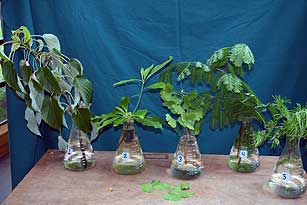“One is the loneliest number…”

(July 25 – August 7, 2016)
The University of Washington Botanic Gardens is home to truly one of a kind plants. In botanical nomenclature, a monotypic genus refers to the case where a genus and only a single species are described. These plants are often “living fossils”, comprising the last living remnant of ancient lineages. Many are also often in the IUCN Red List of Threatened Species.
1) Davidia involucrata var. vilmoriniana Dove Tree
- Davidia involucrata is the only member of the genus Davidia. It was named after French priest and naturalist, Father Armand David who was also the first westerner to describe the giant panda. In 1899, David commissioned a young Kew-trained botanist named Ernest Wilson to travel to China to find the dove tree. This presented a challenge for 22-year-old Wilson, who had never been abroad before and did not speak a word of Chinese.
2) Franklinia alatamaha Franklin Tree
- William Bartram was the first to report the extremely limited distribution of Franklinia. “We never saw it grow in any other place, nor have I ever since seen it growing wild, in all my travels, from Pennsylvania to Point Coupe, on the banks of the Mississippi, which must be allowed a very singular and unaccountable circumstance; at this place there are two or 3 acres of ground where it grows plentifully.” (W. Bartram 1791: 468). The tree was last verified in the wild in 1803 by the English plant collector, John Lyon.
3) Ginkgo biloba Maidenhair Tree
- The Maidenhair Tree was thought to have become extinct, similarly to the other members of its ancient lineage, until it was discovered in Japan in 1691. The Maidenhair Tree remains virtually unchanged today and represents the only living bridge between ‘higher’ and ‘lower’ plants (between ferns and conifers).
4) Metasequoia glyptostroboides Dawn Redwood
- Considered one of the greatest botanical finds of the 20th century, the Dawn Redwood was known only from ancient fossils until a small population was discovered in the forests of central China in 1944. The mature, large trees have all been declared protected; habitat protection is overall inadequate, which means that the survival of this very interesting species in its natural habitat is not guaranteed. (Bartholemew 1983, Fu and Jin 1992, Wang and Guo 2009).
5) Pseudolarix amabilis Golden Larch
- The famous plant explorer, Robert Fortune first saw this unusual conifer as a container plant in China. Wild specimens have been found in the Wuyi Shan of Fujian, and in the Lushan of Jiangxi. Mixed mesophytic forests have been set aside as protected reserves on the Tienmu Shan and Lu Shan, and these include some of the most diverse temperate forests on earth.